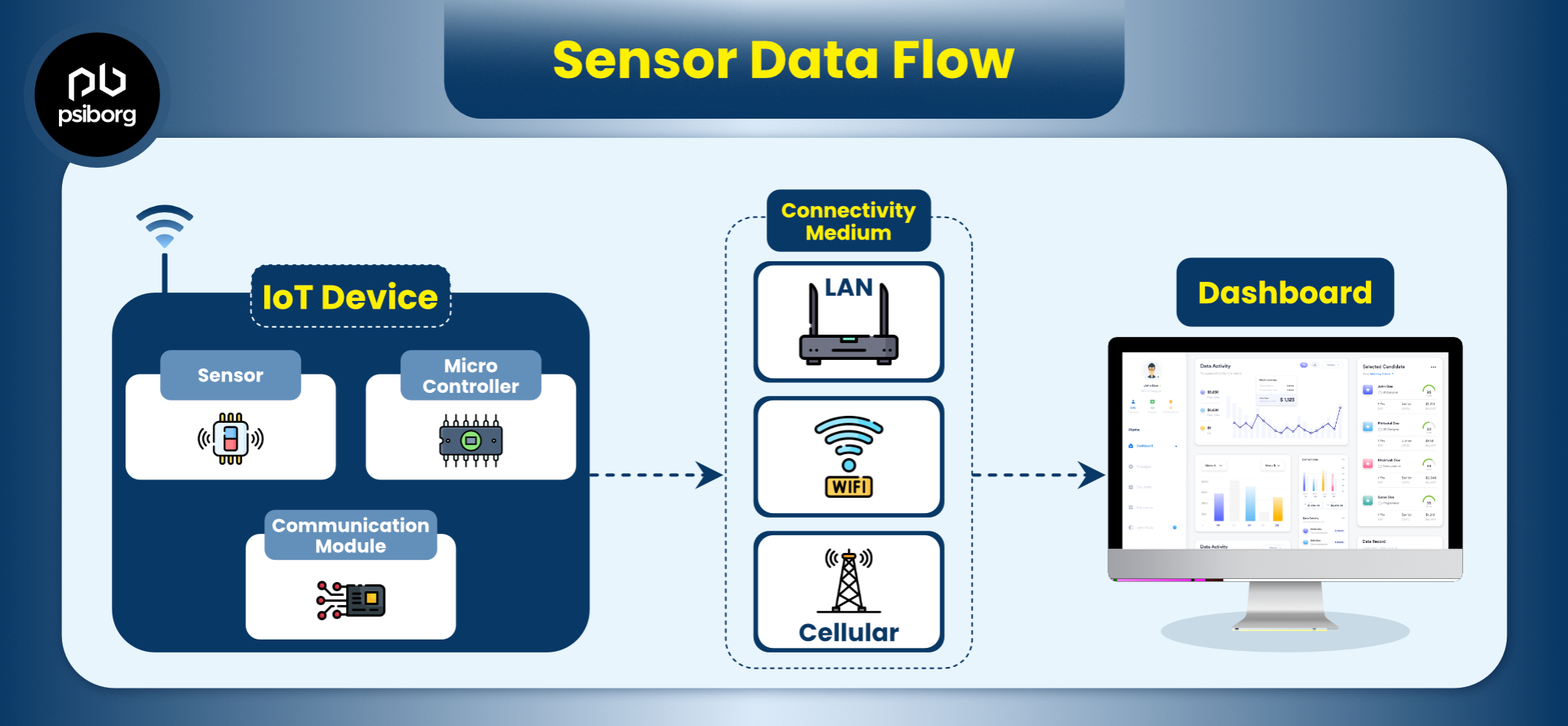With the occurrence of all the uncommon climate crises and environmental hazards, it has become increasingly important to follow the practice of environmental monitoring in order to keep track of the impact humans are facing around the world.
Here, IoT technology is considered the most promising technology when it comes to tracking and monitoring.
An environmental monitoring system using IoT will allow us to gather real-time data on various environmental parameters, for instance, air quality, water quality, soil quality, and much more, leading us to take some actionable insights.
Moreover, technological advancement has always been closely related to environmental sustainability, and people perceive that technological advancements will have an unfavorable impact on the environment.
Contrary to this belief, the relationship between technology and the environment has changed because the factors that catalyze technological innovations and sustainability have been removed. The new sustainable change has led to the birth of some immersive technologies like robotics, AI, and the Internet of Things.
Being an IoT service-providing company, we will of course talk about the Internet of Things. Wireless connectivity and IoT sensor technologies have mutually strengthened sustainability and digital innovation.
Today, IoT based environmental monitoring systems enable industries and organizations to monitor and detect harmful substances, chemicals, pollutants, and more.
So let’s talk about how IoT can benefit the environment and why environmental monitoring systems using IoT are in demand at the moment.
WHAT IS IOT ENVIRONMENTAL MONITORING?
IoT based environmental monitoring can be explained as a process that utilizes Internet of Things (IoT) technology to collect real-time precise data about the environment.
The environmental monitoring system uses IoT environmental monitoring sensors and connected devices for the collection of data measurements from our physical environment.
For instance, the sensors embedded in pipelines, weather stations, oceanic applications, or industries can detect temperature, pressure, moisture, water level, leakage, and many other physical properties.
Further, the connected devices with embedded communication modules can then process and analyze the information and send this critical data to the cloud or to the data center to let humans take further steps.
So, we can say that an environmental monitoring system using IoT will act as the eyes, ears, and mouth of an application to watch, listen, and communicate vast amounts of data, and sometimes the system is also capable of taking actions to prevent damage.
WHAT IS A WIRELESS SENSOR NETWORK?
A Wireless sensor network is a network of devices that can communicate the information sourced from a monitored environment via a wireless network. The data is sent ahead through different nodes. Then, through a gateway, the data is shared with other networks. IoT based Environmental Monitoring is one of the major applications of Wireless Sensors Networks.
Wireless Sensor Network in IoT is a wireless network that consists of base stations and a number of nodes (wireless sensors). These networks are used to keep an eye on physical or environmental conditions like sound, pressure, and temperature, and relay the data through the network to the control station. WSN in IoT helps achieve the full potential of IoT technology.
COMPONENTS OF WSN :
1. Sensors: The sensors in WSN are used to pick up the environmental variables data, and the sensor signals are then converted into electrical signals.
2. Radio Nodes: We will receive the data generated by the sensors and forward the same to the WLAN access point. It comprises a transceiver, external memory, and power source.
3. WLAN Access Point / IoT Gateway: It receives the data from the Radio nodes wirelessly.
4. IoT Edge Computing: IoT Edge Gateway processes the received data from Radio Nodes. The processed data is used for further processing of the data for analysis, storage, and mining of the data.
DESIGNING TOPOLOGY OF WIRELESS SENSOR NETWORK
An optimal logical topology of a wireless sensor network (WSN) helps the deployed sensor nodes to communicate with each other with little overheads, lowers energy usage, increases the lifetime of the network, provides scalability, raises reliability, and brings down latency. Numerous factors need to be considered in designing an optimal logical topology for a WSN. Chain-oriented topologies have led to a number of improvements in energy consumption, lifetime, and load balancing compared to other topologies of WSNs. However, their limitations include latency, scalability, reliability, and interference problems.

WIRELESS SENSOR NETWORK FOR ENVIRONMENTAL MONITORING APPLICATIONS AND SCOPE
One of the most important and widespread applications of Wireless Sensor Networks is Environmental monitoring. An environmental monitoring system using IoT is not a short period of monitoring but one that extends over months, years, and even a lifetime sometimes. The lifetime of the sensor network is limited by the constraints of limited battery power in Battery powered Sensor nodes. This has indeed emerged as a key hurdle in upscaling WSNs for environmental monitoring. In recent times, WSNs have emerged to be vitally important in keeping an eye on real environmental changes such as global warming. These days, the increased frequency and intensity of natural disasters have also necessitated the use of well-functioning WSNs to predict or warn about natural disasters.
IOT BASED ENVIRONMENTAL MONITORING FOR AIR QUALITY, CARBON DIOXIDE, SMOG-LIKE GASES, CARBON MONOXIDE IN CONFINED AREAS, INDOOR OZONE LEVELS
Air quality sensors are devices used to detect contaminants in the air. This includes particulates, pollutants, and noxious gases that may be harmful to human health. They are used in applications like air quality monitoring, gas detection in industry, combustion controllers, and oxygen generators in aircraft. Volatile organic compound (VOC) sensors are available that are capable of detecting volatile chemicals and odorous pollutants.
MONITORING OF WATER FOR QUALITY, POLLUTANTS AND THERMAL CONTAMINANTS
Water quality sensor data is commonly used for various management purposes, such as meeting regulatory requirements, identifying key non-regulatory aspects for users, validating water quality models, and alerting for contamination.
The chemical, biological, and physical conditions of water indicate its quality in numerous ways. Even small shifts in these characteristics can impact people and industries that rely on water. To maintain quality, tracking water parameters like conductivity, dissolved oxygen, pH, salinity, temperature, and turbidity is essential.
IOT BASED ENVIRONMENTAL MONITORING OF SOIL FOR MOISTURE AND VIBRATION LEVELS TO DETECT LANDSLIDES
Wireless Sensor Networks can monitor soil for landslides, using slopes, moisture, and vibration sensors to provide predictive data.
Another similar application is the monitoring of agricultural fields using various sensors which provide insightful data to grow crops more efficiently.
MONITORING FORESTS AND PROTECTED LANDS FOR FOREST FIRES
Wireless sensor networks (WSN) can be deployed in a large number of systems, with one potential application being forest fire detection. Sensors are able to influence physical parameters such as pressure, temperature, gases, radiation, humidity, and many other parameters. Sensor networks are normally deployed in large-scale random distributions in remote or inaccessible places and under harsh environments for a certain period of their lifetime. This technology relied on low data rates and short ranges of communication in a multi-hop fashion to reach the sink.
MONITORING FOR NATURAL DISASTERS LIKE EARTHQUAKES AND TSUNAMI WARNING
All over the world, authorities are installing seismic sensors along with structural health monitoring(SHM) sensors (such as 3-axis deflection, vibration, stress, strain, etc. ) on important structures like bridges, power transmission poles, hospitals, etc. active seismic zones. Such seismic monitoring equipment and instruments help scientists to estimate the damages from minor earthquakes. Then, by taking help from mathematical models, it becomes possible to predict the damage caused by major earthquakes.
MONITORING FISHERIES FOR BOTH ANIMAL HEALTH AND POACHING
These days, continuous real-time monitoring of the water quality of inland fisheries is possible. The parameters being monitored are pH, temperature, turbidity, water level, dissolved oxygen & nitrogen, and area-wise fish density. These systems also have provisions for:
(i) restoring water level if it decreases below the threshold and
(ii) automatic feed mechanism for fishes.
MONITORING SNOWFALL LEVELS AT SKI RESORTS AND IN NATURAL FORESTS FOR WEATHER TRACKING AND AVALANCHE PREVENTION
Snow levels can be monitored using ultrasonic sensors. Snow ultrasonic sensors are able to continuously measure snow depth. These are commonly used for hydrological monitoring and avalanche prediction. In natural forests, monitoring snow levels can give an idea about weather conditions.
MONITORING DATA CENTERS FOR AIR TEMPERATURE AND HUMIDITY
As soon as there is a change in environmental conditions, a server, router, gateway, or other devices, the sensors notice it and the system sends alarm messages to designated personnel. Parameters such as temperature and humidity are monitored using such a sensor system.
The following are some of the important parameters monitored using the Wireless Sensor Network (WSN).
- Airflow
- Gas
- Pressure
- Flood and leak
- Humidity
- Temperature
AIR FLOW SENSORS
Air flow sensors are used to control airflow in ventilation and air-conditioning. Moreover, they are utilized in IoT based wireless sensor networks for air pollution monitoring. These are quite easy to install and control the total pressure, the static pressure of the airflow, and the average velocity of air.
GAS SENSORS
The aforementioned gas sensors are deployed for monitoring and detecting changes in air quality and the presence of toxic, combustible, or hazardous gases. These sensors have a variety of applications in industries such as mining, oil and gas, chemical research, and manufacturing. One of the most common uses of gas sensors is in consumer-based carbon dioxide detectors, which can be found in many homes.
PRESSURE SENSORS
A pressure sensor is used to detect pressure changes. It senses changes in the pressure of gases and liquids. When the pressure changes, the sensor detects these changes and communicates them to connected systems. The most common use cases of pressure sensors include leak testing, which can be a result of decay. Pressure sensors are also suitable for use in the manufacturing of water systems as they are easily able to detect fluctuations or drops in pressure.
FLOOD AND LEAK SENSORS
These sensors are able to detect the presence of water, fuel, and other types of liquids. Wireless rope sensors issue alerts regarding liquid spillages, pump failures, or floods over wide areas. Wireless leak sensors can be mounted on walls or along pipes to detect leaks and frozen water. Besides detecting leaks, wireless sensors are also used to monitor water levels in diverse environments.
Wireless ultrasonic level sensors can be used to track water levels in lakes, reservoirs, storage tanks, and rivers.
HUMIDITY SENSORS
Humidity sensors measure the amount of water vapor or moisture content in the atmosphere of air or other environments. These sensors are commonly used in heating, ventilation, and air conditioning systems in both industrial and residential settings. They are also utilized in hospitals and meteorology stations to compile weather reports and predict meteorological conditions.
TEMPERATURE SENSORS
Temperature sensors are devices that detect changes in temperature by measuring the amount of heat energy in a source. The recorded temperature data is then translated into meaningful information. These sensors have a wide range of applications, commonly used in manufacturing machinery where specific environmental and device temperatures are critical. They are also crucial in agriculture, where soil temperature plays a critical role in crop growth.
These sensors can be installed using LPWAN such as SigFox, Sub-1 GHz or LoRaWAN.
Also Read: Monitoring of the environment with the help of Wireless IoT Sensors.
Nevertheless, PsiBorg, an IoT service provider, specializes in designing and building Wireless Sensor Networks for environmental monitoring. We build the most cutting-edge WSN solutions tailor-made for your requirements and satisfaction.
FAQ
Environmental monitoring is a technique designed to observe the surrounding environment, characterize its quality, and analyze its parameters. This is all done to accurately monitor the impact of human activity on the environment and vice versa.
The list of IoT devices used in environmental monitoring systems includes sensors, data loggers, remote monitoring systems, IoT-enabled systems, geographic information systems, and much more.
Environmental monitoring has become very important at present because it is employed to manage and minimize the impact of human activities on the environment, either to ensure compliance or to reduce the risk of harmful effects on the natural environment and protect the health of human beings.






